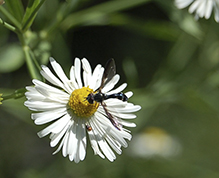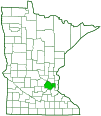cobalt hover fly
(Pelecinobaccha costata)
Conservation • Description • Habitat • Ecology • Distribution • Taxonomy
Conservation Status |
|
|||||||
| IUCN Red List | not listed |
|||||||
| NatureServe | NNR - Unranked |
|||||||
| Minnesota | not listed |
|||||||
Description |
||
Pelecinobaccha is a recently defined genus with 53 species. Only one species occurs north of Mexico. Cobalt hover fly is an uncommon, small, slender, hover fly. It occurs in the United States east of the Great Plains and in southern Ontario Canada. It is uncommon throughout its range, rare in Minnesota. Larvae feed on scale insects in trees and possibly also on aphids. Adults are found from mid-June to late October in forests. Adults are ⅜″ to ½″ (8.7 to 11.5 mm) in length and mostly black with pale yellow markings. In photographs the markings often appear white. The head is wider than the thorax. The rear part of the head is strongly concave and close to the thorax. There are two large compound eyes on the sides of the head and three small simple eyes (ocelli) in a triangle on top of the head. The compound eyes are bare, with no erect hairs. On the male they meet at the top of the head. On the female they do not. The forehead (frons) is mostly black with a narrow pale yellow stripe on each side. On the female the frons is strongly narrowed at the top. The face narrows toward the bottom. It is pale yellow except for a narrow black stripe in the middle that does not reach the lower margin. The protruding mouthpart (proboscis) is short and fleshy. The antennae are short, shorter than the head, and have just three segments. The first two segments, the scape and pedicel, are short, not longer than wide. The third segment is no more than two times as long as wide, and it has a stiff, forward-pointing bristle (arista) above. The thorax is large, black, and shiny. The middle and largest plate (scutum) is hairless above except for one or two transverse rows of long hairs near the front margin. On each side of the scutum, in the shoulder (humeral) area just behind the head, there is a small plate (postpronotum). The postpronotum is bare, with no hairs or bristles. Unfortunately, this is not visible without first removing the fly’s head. The small rear part of the thorax (scutellum) is blackish-brown and more or less translucent. The abdomen is slender and long, at least ten times as long as the width of the second abdominal segment (tergite). It is strongly petiolate, very narrow in front and oval behind. Tergite 1 is very short and is shiny bluish-black. Tergites 2 through 6 are mostly opaque black above with bluish-black on the margins. Tergite 2 is long and slender. Tergites 3 and 4 each have a small, triangular, pale yellow spot on both sides. Tergite 5 usually has at least a trace of these spots. On the male, tergite 5 is visible when viewed from above. The front and middle legs are pale orange. On the hind legs the third segment (femur) is pale orange on the basal half, dark brown on the outer half. The fourth segment (tibia) is yellow on the basal third, dark brown on the outer two thirds. The wings are dark brown on the front half, clear on the rear half. The medial discal (dm) cell is always clear. There is a false (spurious) vein between the radius (R) and media (M) veins and parallel to them. It is not a true vein but rather a streak of discoloration. The anal cell is long and is closed near the wing margin. The marginal, R5, and M2 cells are also closed. The R4+5 vein is forked. |
||
Size |
||
⅜″ to ½″(8.7 to 11.5 mm) |
||
Similar Species |
||
Habitat |
||
Forests |
||
Ecology |
||
Season |
||
Late June to mid-October |
||
Behavior |
||
|
||
Life Cycle |
||
|
||
Larva Food |
||
Scale insects |
||
Adult Food |
||
|
||
Distribution |
||||
|
Sources |
|||
| 12/12/2022 | ||||
Occurrence |
||||
|
||||
Taxonomy |
|||
Order |
|||
Suborder |
Brachycera |
||
Infraorder |
Cyclorrhapha |
||
| Zoosection | Aschiza |
||
Family |
Syrphidae (Hover Flies) |
||
Subfamily |
Syrphinae (Typical Hover Flies) | ||
Tribe |
Syrphini |
||
Genus |
Pelecinobaccha | ||
All of the species in the genus Pelecinobaccha were formerly included in the genus Ocyptamus. A recent molecular phylogenetic study (Mengual, Ximo [2012]) showed that the genus was not composed of a common ancestor and all of its descendants (non-monophyletic). The authors divided the genus into several monophyletic subgroups but declined to split the genus. One of the groups was Pelecinobaccha. A later revision of the Pelecinobaccha (Miranda et al., 2014) raised it to the genus level. |
|||
Synonyms |
|||
Ocyptamus costatus |
|||
Common Names |
|||
cobalt hover fly |
|||
Glossary
Arista
A large bristle on the upper side of the third segment of the antenna of a fly. Plural: aristae.
Femur
On insects and arachnids, the third, largest, most robust segment of the leg, coming immediately before the tibia. On humans, the thigh bone.
Frons
The upper front part of an insect’s face, roughly corresponding to the forehead.
Ocellus
Simple eye; an eye with a single lens. Plural: ocelli.
Pedicel
On plants: the stalk of a single flower in a cluster of flowers. On insects: the second segment of the antennae. On Hymenoptera and Araneae: the narrow stalk connecting the thorax to the abdomen: the preferred term is petiole.
Proboscis
The tube-like protruding mouthpart(s) of a sucking insect.
Scape
In plants: An erect, leafless stalk growing from the rootstock and supporting a flower or a flower cluster. In insects: The basal segment of the antenna.
Scutellum
The exoskeletal plate covering the rearward (posterior) part of the middle segment of the thorax in some insects. In Coleoptera, Hemiptera, and Homoptera, the dorsal, often triangular plate behind the pronotum and between the bases of the front wings. In Diptera, the exoskeletal plate between the abdomen and the thorax.
Scutum
The forward (anterior) portion of the middle segment of the thorax (mesonotum) in insects and some arachnids.
Tergite
The upper (dorsal), hardened plate on a segment of the thorax or abdomen of an arthropod or myriapod.
Tibia
The fourth segment of an insect leg, after the femur and before the tarsus (foot). The fifth segment of a spider leg or palp. Plural: tibiae.
Visitor Photos |
|||||
Share your photo of this insect. |
|||||
| This button not working for you? Simply email us at info@MinnesotaSeasons.com. Attach one or more photos and, if you like, a caption. |
|||||
Bob Payton |
|||||
 |
|||||
MinnesotaSeasons.com Photos |
|||||
|
|||||

Slideshows |
||

Visitor Videos |
|||
Share your video of this insect. |
|||
| This button not working for you? Simply email us at info@MinnesotaSeasons.com. Attach a video, a YouTube link, or a cloud storage link. |
|||
Other Videos |
|||
| Hoverfly (Ocyptamus costatus) Geeky Cyberpunk Reference |
|||
About
Aug 17, 2019 These macro videos were recorded with my Samsung Galaxy J7 Crown, and posted to demonstrate that this cheap phone can produce pretty good video. Creating the videos has two stages: first, I record them in macro ("flower") mode at 1920x1080 with 2x digital zoom*. Second, I crop the 1920x1080 videos to 1280x720 because the tiny subjects take up so little of the frame and cropping allows them to be viewed even larger. Some of the video clips have been software stabilized/"deshaked", but not otherwise enhanced. (*With video, digital zoom is really "real" zoom without software resampling as long as the horizontal resolution of the video multiplied by the magnification is less than or equal to the horizontal resolution of the sensor. For example, the 13 MP sensor on the Galaxy J7 Crown is 4128 pixels wide, allowing it to do "real" zoom of 1920x1080 videos at up to 2.15x without software resampling, or 1280x720 video at up to 3.225x.) |
|||

Created: 12/12/2022
Last Updated:


